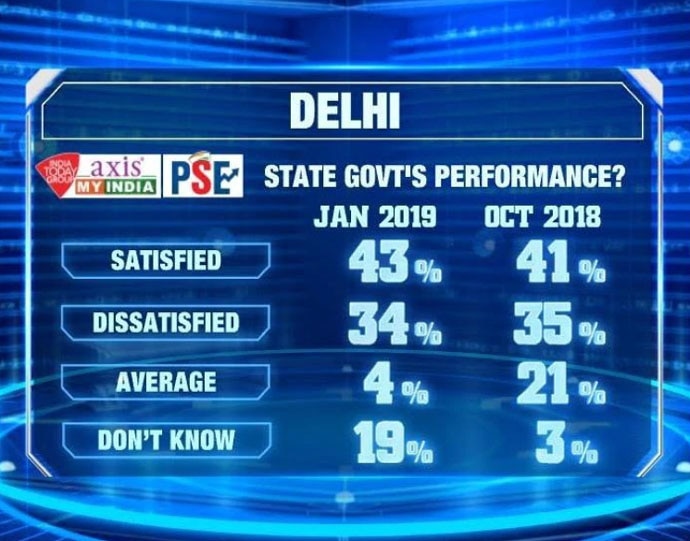Arvind Kejriwal and AAP's popularity rises. What's fuelling this spike?

The temperature in the national capital may be plummeting — but the Aam Aadmi Party (AAP) and its national convener Arvind Kejriwal’s popularity is rising.

While anti-incumbency may have brought down BJP governments in Rajasthan, Madhya Pradesh and Chhattisgarh recently, the AAP government in Delhi seems untouched by biting public sentiment against it.
According to India Today's Political Stock Exchange (PSE), over the last two months, Arvind Kejriwal has emerged as the clear choice for Delhi’s chief minister.
Both Kejriwal and his party have climbed two per cent each on the performance meter since October, when the PSE poll was last conducted.

As many as 49 per cent of the respondents backed Kejriwal as chief minister of Delhi — that's against 47 per cent in October.
While the popularity of BJP leader Major Tiwari as a possible CM has also risen by five notches since the last count, he still falls behind Kejriwal by many miles.
More importantly, 43 per cent people expressed satisfaction with the work done by the AAP government in Delhi since 2015.

The highs and the lows
In 2015, in Delhi's 70-member Assembly, Kejriwal's AAP swept that year's polls, securing 67 seats. The remaining three seats were won by the BJP.
The results that emerged in Delhi challenged the narrative of a 'Narendra Modi wave' sweeping the country.
Since 2015 though, the AAP has been hit by several controversies, desertions by senior leaders and legal suits — and yet, the party continues as the first choice for a majority of Delhiites.
Delhi has about 40 per cent migrant voters from Bihar and UP, mostly self-employed and belonging to the Dalit and backward castes. This group is believed to be a huge supporter of the AAP.
The appointment of Manoj Tiwari as the Delhi BJP chief in 2016 was believed to be a step aimed at attracting this voter base to the party.
But AAP, it seems, is quicker to learn from mistakes and make amends. The first big shocker for the party in Delhi came on April 13, 2017, when the result for the Rajouri Garden Assembly by-poll was announced. AAP’s candidate Harjeet Singh had to forfeit his deposit and the party’s vote share tanked from 47 per cent in 2015 to 13.1 per cent.
The second shocker came for the party just a few days later when the party lost the municipal corporation elections to the BJP, the results of which were announced on April 26, 2017.
With the AAP emerging as a distant second in the civic body elections, the party started blaming EVMs for the results. This led observers to blame AAP for acting as a sore loser.

Also, direct attacks that Kejriwal launched against political opponents on national issues gave an impression that AAP was ready to compromise on Delhi’s governance for its growing national ambitions.
With Kejriwal himself facing a number of libel cases since, it started to appear like the party was beginning to lose both the plot and the pulse of the people in Delhi.
Course correction
Fortunately, for the party, course correction came in quickly.
Kejriwal unhesitatingly issued apology after apology to those he had offended, thus going on to ensure litigations against him including serious defamation charges were withdrawn.
Almost simultaneously, Kejriwal and other AAP leaders started talking about the development work done in Delhi — this included a portfolio of projects undertaken in mohalla clinics and improvements in government schools.
With his 'common man' image, Kejriwal revived his relationship with the aam janata of Delhi, a group of citizens that clearly wants its leaders to talk about bijli, sadak and paani, and not, as in other parts of India, identity politics.
While the party has been seen falling back on its old ways of conducting politics every now and then, AAP has mostly succeeded in keeping the narrative focused on development.

Several schemes/plans of the AAP government have earned it the image of a pro-development party anew.
The AAP’s decision to conduct a pan-Delhi socio-economic survey, which aims to map benefits of social security schemes with beneficiaries, to mitigate exclusionary errors, is one such move.
The launch of door-to-door delivery of public services via ‘mobile sahayaks’ is another transformative move.
AAP was also among the first parties to announce the de-linking of Aadhaar from the pensions of widows, old-age pensioners and the differently-abled — a move people truly welcomed.
While some of its promises, such as passing the Jan Lokpal Bill and making Delhi a ‘WiFi city’, are yet to see light of day, a majority of Delhiites seem to believe in AAP’s ‘intent’.
In these politically uncertain times, that is no small achievement.

